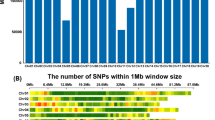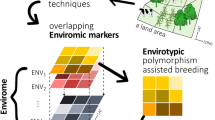Abstract
Genetic means for height growth differed between intra- and inter-provenance crosses, which we hypothesized was due partly to unidentified relatedness among intra-provenance base parents resulting in mild inbreeding and inbreeding depression among their offspring. A dense array of 5,844 single nucleotide polymorphisms was used to directly construct a genomic relationship matrix (G) that had four elements ranging from 0.17 to 0.24, between five intra-provenance base parents. Adjusting the numerator relationship matrix for this relatedness among base parents produced inbreeding coefficients of F i ≈ 0.1 in their offspring, which displayed depressed height growth. Accounting for inbreeding level as a covariate in a mixed model decreased grossly overestimated (up to 2 ×) dominance variance in models without the covariate adjustment. Height growth decreased 39 cm (∼ 6 %) for every 0.1 increase in F i .




Similar content being viewed by others
References
Abney M, McPeek MS, Ober C (2000) Estimation of variance components of quantitative traits in inbred populations. Am J Hum Genet 66(2):629–650
Beaulieu J (1996) Breeding program and strategy for white spruce in Québec. Information Report LAU-X-117E. Natural Resources Canada, Canadian Forest Service, Québec
Blouin MS (2003) DNA-based methods for pedigree reconstruction and kinship analysis in natural populations. Trends Ecol Evol 18(10):503–511
Boyle T (1987) A diallel cross in black spruce. Genome 29(1):180–186
Burdon RD, Namkoong G (1983) Multiple populations and sublines. Silvae Genet 5–6:221–222
Burdon RD, Russell JH (1998) Inbreeding depression in selfing experiments: statistical issues. For Genet 5(3):179–189
Bush D, Kain D, Matheson C, Kanowski P (2011) Marker-based adjustment of the additive relationship matrix for estimation of genetic parameters—an example using Eucalyptus cladocalyx. Tree Genet Genomes 7(1):23–35
Cheng R, Abney M, Palmer A, Skol A (2011) QTLRel: an R package for genome-wide association studies in which relatedness is a concern. BMC Genet 12(1):66
Coles JF, Fowler DP (1976) Inbreeding in neighboring trees in two white spruce populations. Silvae Genet 25(1):29–34
de los Campos G, Gianola D, Rosa GJM, Weigel KA, Crossa J (2010) Semi-parametric genomic-enabled prediction of genetic values using reproducing kernel Hilbert spaces methods. Genet Res 92(04):295–308
Doerksen TK, Deslauriers M, Beaulieu J (2011) Ecological and biological information improves inferred paternity in a white spruce breeding orchard. Can J For Res 41:1344–1351
Durel CE, Bertin P, Kremer A (1996) Relationship between inbreeding depression and inbreeding coefficient in maritime pine (Pinus pinaster). Theor Appl Genet 92(3–4):347–356
Falconer DS, Mackay TFC (1996) Introduction to quantitative genetics, 3rd edn. Longman, Harlow, England
Hadfield JD (2010) MCMC methods for multi-response generalized linear mixed models: the MCMCglmm R package. J Stat Softw 33(2):1–22
Hamrick JL, Godt MJW, Sherman-Broyles SL (1992) Factors influencing levels of genetic diversity in woody plant species. New For 6(1–4):95–124
Hodge GR, Volker PW, Potts BM, Owen JV (1996) A comparison of genetic information from open-pollinated and control-pollinated progeny tests in two eucalypt species. Theor Appl Genet 92(1):53–63
Jansson G, Li B (2004) Genetic gains of full-sib families from disconnected diallels in loblolly pine. Silvae Genet 53(2):60–64
Jaramillo-Correa JP, Beaulieu J, Bousquet J (2001) Contrasting evolutionary forces driving population structure at expressed sequence tag polymorphisms, allozymes and quantitative traits in white spruce. Mol Ecol 10(11):2729–2740
Jones AG, Small CM, Paczolt KA, Ratterman NL (2010) A practical guide to methods of parentage analysis. Mol Ecol Resour 10(1):6–30
Kumar S (2004) Effect of selfing on various economic traits in Pinus radiata and some implications for breeding strategy. For Sci 50(5):571–578
Kumar S, Richardson TE (2005) Inferring relatedness and heritability using molecular markers in radiata pine. Mol Breeding 15(1):55–64
Lee SH, Goddard ME, Visscher PM, Van Der Werf JHJ (2010) Using the realized relationship matrix to disentangle confounding factors for the estimation of genetic variance components of complex traits. Genet Sel Evol 42:22
Legarra A, Aguilar I, Misztal I (2009) A relationship matrix including full pedigree and genomic information. J Dairy Sci 92(9):4656–4663
Lindgren D (1975) Use of selfed material in forest tree improvement. Research Notes 15, The Royal College of Forestry. Department of Forest Genetics, Stockholm
Lynch M, Walsh B (1998) Genetics and analysis of quantitative traits. Sinauer Associates Inc., Sunderland, MA
Mäki-Tanila A (2007) An overview on quantitative and genomic tools for utilising dominance genetic variation in improving animal production. Agr Food Sci 16(2):188–198
Misztal I (1997) Estimation of variance components with large-scale dominance models. J Dairy Sci 80(5):965–974
Mrode R (2006) Linear models for the prediction of animal breeding values. CABI, Wallingford
Mullin TJ, Park YS (1994) Genetic parameters and age–age correlations in a clonally replicated test of black spruce after 10 years. Can J For Res 24(12):2330–2341
Namkoong G, Kang H (1990) Quantitative genetics of forest trees. Plant Breed Rev 8:139–188
Namroud MC, Beaulieu J, Juge N, Laroche J, Bousquet J (2008) Scanning the genome for gene single nucleotide polymorphisms involved in adaptive population differentiation in white spruce. Mol Ecol 17(16):3599–3613
Ovaskainen O, Cano JM, Merilä J (2008) A Bayesian framework for comparative quantitative genetics. P R Soc B 275:669–678
Patterson HD, Williams ER (1976) A new class of resolvable incomplete block designs. Biometrika 63(1):83–92
Pavy N, Gagnon F, Rigault P, Blais S, Deschênes A, Boyle B, Pelgas B, Deslauriers M, Clément S, Lavigne P, Lamothe M, Cooke JEK, Jaramillo-Correa JP, Beaulieu J, Isabel N, MacKay J, Bousquet J (2013) Development of high-density SNP genotyping arrays for white spruce (Picea glauca) and transferability to subtropical and nordic congeners. Mol Ecol Resour 13:324–336
Pemberton J (2004) Measuring inbreeding depression in the wild: the old ways are the best. Trends Ecol Evol 19(12):613–615
Piepho HP (2009) Ridge regression and extensions for genomewide selection in maize. Crop Sci 49(4):1165–1176
Plummer M, Best N, Cowles K, Vines K (2006) CODA: convergence diagnosis and output analysis for MCMC. R News 6(1):7–11
R Development Core Team (2012) R: A language and environment for statistical computing. R Foundation for Statistical Computing, Vienna
Ritland K (1996) Inferring the genetic basis of inbreeding depression in plants. Genome 39(1):1–8
Santure AW, Stapley J, Ball AD, Birkhead TR, Burke T, Slate J (2010) On the use of large marker panels to estimate inbreeding and relatedness: empirical and simulation studies of a pedigreed zebra finch population typed at 771 SNPs. Mol Ecol 19(7):1439–1451
Shaw RG, Byers DL, Shaw FH (1998) Genetic components of variation in Nemophila menziesii undergoing inbreeding: morphology and flowering time. Genetics 150(4):1649–1661
Sillanpää MJ (2011) On statistical methods for estimating heritability in wild populations. Mol Ecol 20:1324–1332
Spiegelhalter DJ, Best NG, Carlin BP, van der Linde A (2002) Bayesian measures of model complexity and fit. J R Stat Soc Ser B 64(4):583–639
Su G, Christensen OF, Ostersen T, Henryon M, Lund MS (2012) Estimating additive and non-additive genetic variances and predicting genetic merits using genome-wide dense single nucleotide polymorphism markers. PLoS ONE 7(9):e45293
VanRaden P (2008) Efficient methods to compute genomic predictions. J Dairy Sci 91(11):4414–4423
Waldmann P, Hallander J, Hoti F, Sillanpää MJ (2008) Efficient Markov chain Monte Carlo implementation of Bayesian analysis of additive and dominance genetic variances in noninbred pedigrees. Genetics 179(2):1101–1112
Walsh B (2005) The struggle to exploit non-additive variation. Aust J Agr Res 56(9):873–881
Wang T, Hagqvist R, Tigerstedt PMA (1999) Inbreeding depression in three generations of selfed families of silver birch (Betula pendula). Can J For Res 29(6): 662–668
White TL, Hodge GR (1989) Predicting breeding values with applications in forest tree improvement. Kluwer, Dordrecht, The Netherlands
Williams CG, Savolainen O (1996) Inbreeding depression in conifers: implications for breeding strategy. For Sci 42(1):102–117
Wu HX, Matheson AC, Spencer D (1998) Inbreeding in Pinus radiata. I. The effect of inbreeding on growth, survival and variance. Theor Appl Genet 97(8):1256–1268
Wu HX, Matheson AC, Abarquez A (2002) Inbreeding in Pinus radiata. IV: the effect of inbreeding on wood density. Ann For Sci 59(5–6):557–562
Wu HX, Owen JV, Abarquez A, Matheson AC (2004) Inbreeding in Pinus radiata - V. The effects of inbreeding on fecundity. Silvae Genet 53(2):80–87
Yanchuk AD (1996) General and specific combining ability from disconnected partial diallels of coastal Douglas-fir. Silvae Genet 45(1):37–45
Acknowledgments
We thank D. Plourde and É. Dussault for site maintenance and data collection; S. Blais and F. Gagnon (U. Laval) for managing the genotype data; and K. Gardner, S. Carles, P. Cheers, and the anonymous reviewers for comments on previous versions of the manuscript. This work was made possible by funding from the Natural Resources Canada Genomics R&D Initiative and the Canadian Wood Fibre Centre to JBe and from Genome Québec and Genome Canada to JBo.
Data archiving statement
Data available from the Dryad Digital Repository: http://dx.doi.org/10.5061/dryad.9m63g
Author information
Authors and Affiliations
Corresponding author
Additional information
Communicated by D. Neale
Rights and permissions
About this article
Cite this article
Doerksen, T.K., Bousquet, J. & Beaulieu, J. Inbreeding depression in intra-provenance crosses driven by founder relatedness in white spruce. Tree Genetics & Genomes 10, 203–212 (2014). https://doi.org/10.1007/s11295-013-0676-y
Received:
Revised:
Accepted:
Published:
Issue Date:
DOI: https://doi.org/10.1007/s11295-013-0676-y




